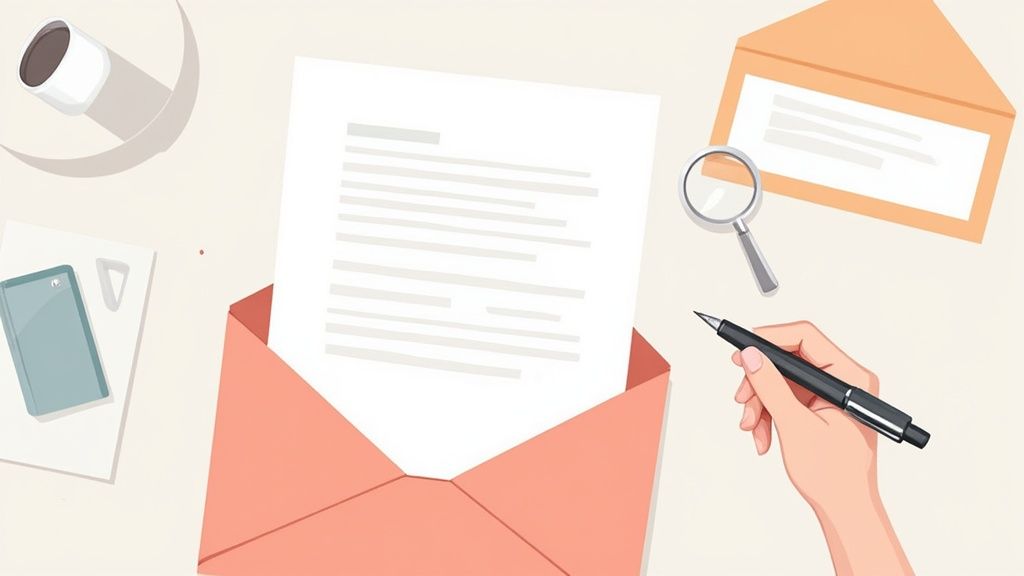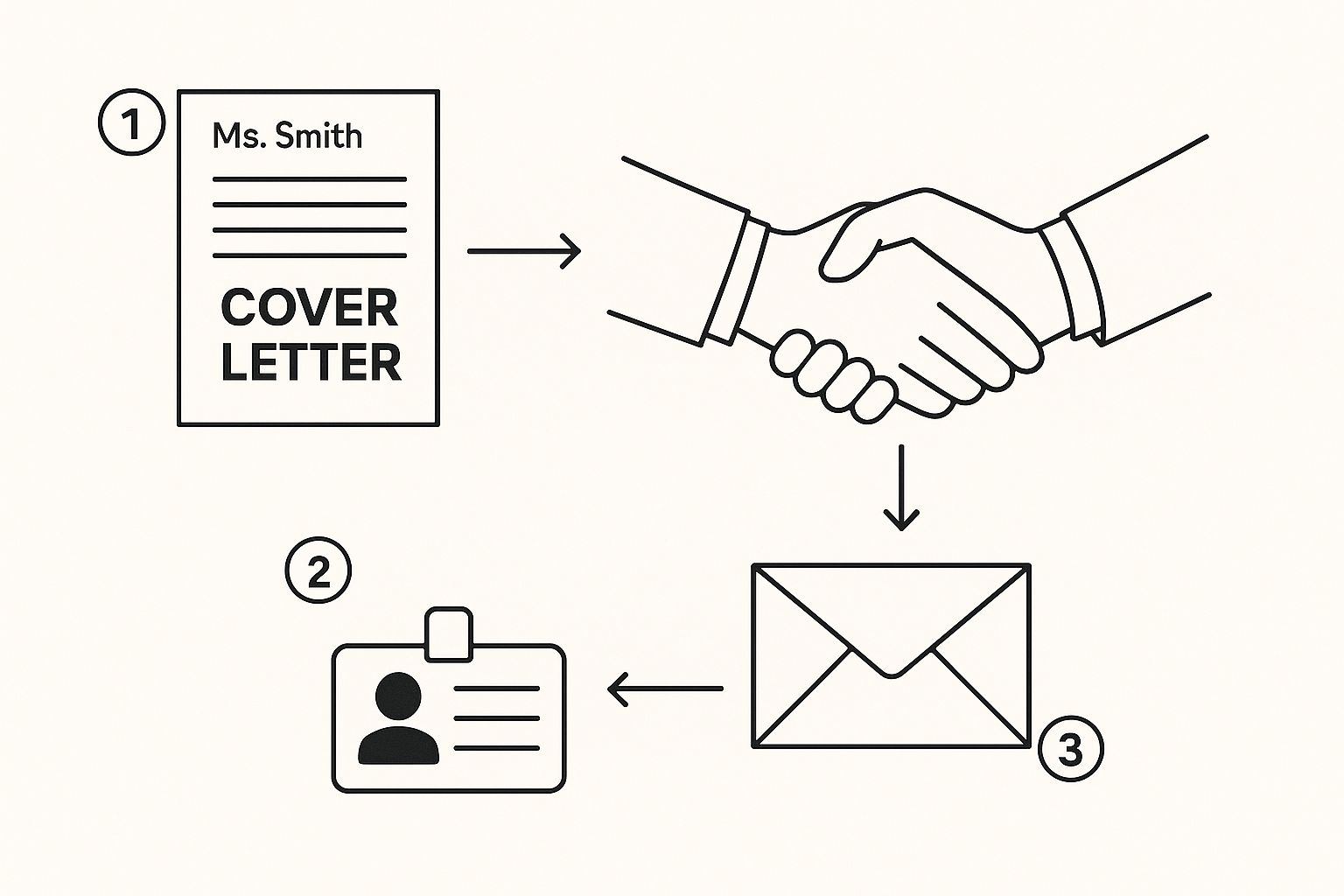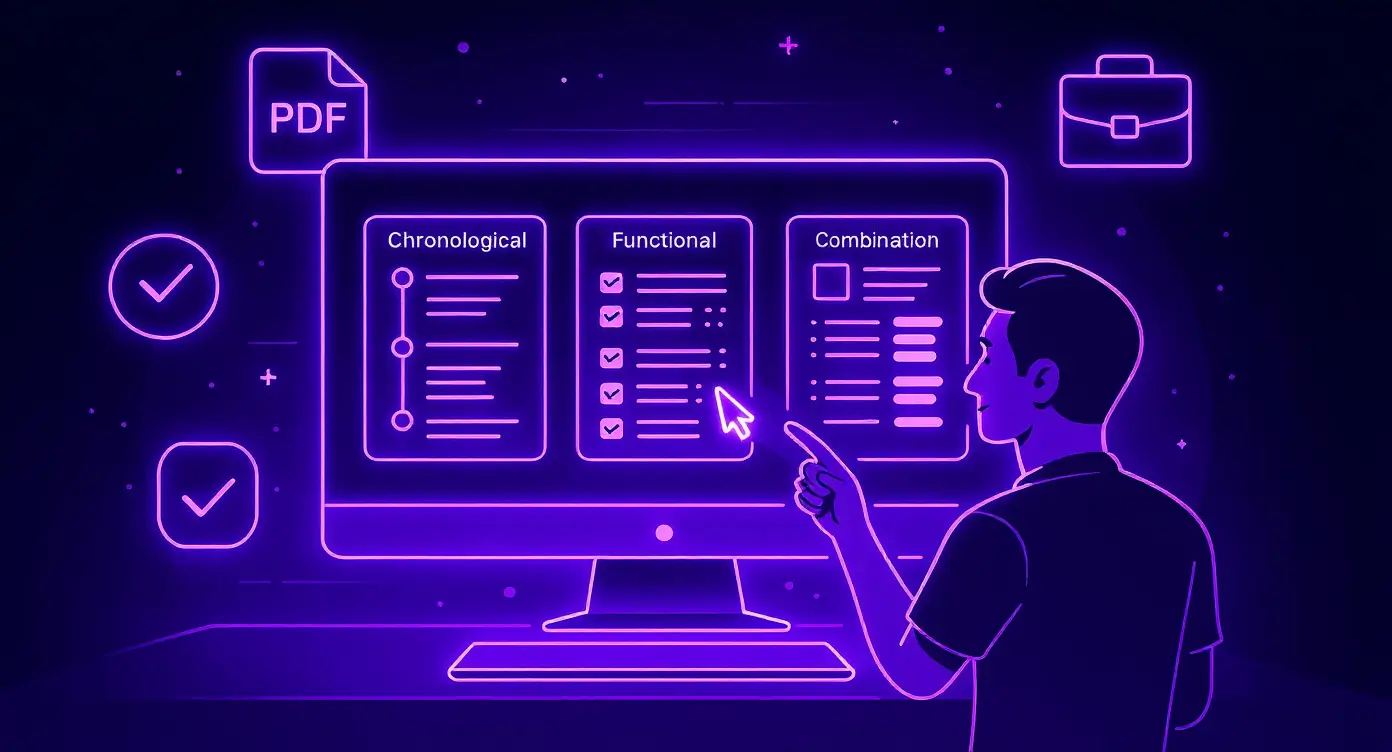How to Address Cover Letter: Tips to Make a Great First Impression

The fastest, most effective way to address a cover letter is with a simple, direct salutation: "Dear [Hiring Manager's Name]." It’s professional, respectful, and instantly shows you’ve put in the effort. That small bit of personalization is your first opportunity to stand out from the crowd of generic applications.
Why Your Cover Letter Salutation Matters
Think of your cover letter's greeting as a digital handshake. It’s the very first impression you make, and it says a lot more than you might think. Getting it right is a strategic move, signaling that you're a candidate who pays attention to the details and does their homework.
And if you think cover letters are a thing of the past, think again. They're your best shot at showing some personality beyond the bullet points of a resume.
A recent analysis of over 80 studies revealed that 89% of hiring professionals still expect a cover letter, and a surprising 72% want one even when the application marks it as optional. That's a clear signal that putting in the time to write a thoughtful letter is anything but a waste of time.
Your cover letter greeting isn't just a formality—it’s the first test of your resourcefulness. A personalized salutation proves you invested time and effort before even writing the first paragraph.
Setting a Professional Tone from the Start
A well-addressed cover letter immediately accomplishes a few critical things.
- It grabs attention: A specific name is far more compelling than a vague, old-fashioned opener like "To Whom It May Concern."
- It shows initiative: It takes a little digging to find the right person's name, and that effort demonstrates your research skills and genuine interest.
- It builds immediate rapport: Using someone's name is a fundamental way to connect and show respect, making the reader more receptive to what you have to say next.
Ultimately, how you kick things off frames the entire document. It’s the difference between a cold, mass-produced application and a warm, targeted introduction. Mastering this first step is huge, but it's only one piece of the puzzle. Understanding what to include in the rest of your cover letter is just as vital for making a lasting impression. A powerful greeting combined with compelling content is a winning formula for landing that interview.
Formatting Your Contact Information Header

Long before a hiring manager reads the first sentence of your cover letter, they see the header. This isn't just a formality; it’s your professional letterhead. It sets the tone for everything that follows.
A clean, professional header shows you're serious and detail-oriented. A sloppy one? Well, it suggests the opposite, and that's not a first impression you want to make. Think of it as the firm handshake that happens before you even start talking.
Your Contact Information
This part is all about making it incredibly easy for them to get in touch with you. Place your details right at the top, either aligned to the left or centered. Stick to the basics, because clarity trumps creativity here.
You absolutely need to include:
- Full Name: Make sure it’s the same one you use on your resume and LinkedIn. Consistency is key.
- Phone Number: Your cell phone is perfect.
- Professional Email Address: Something straightforward like
FirstName.LastName@email.comis the gold standard. - LinkedIn Profile URL: Don't forget to include the link to your profile—and make sure it’s the clean, custom URL, not the messy one with random numbers.
The Employer's Information
Once you've listed your own details and the date, it's time to add the recipient's info. This small step shows you've done your homework and aren't just blasting out generic applications. It’s a targeted approach, and recruiters notice.
A polished header does more than just provide contact details; it creates a cohesive brand identity across your application documents. Aligning the style of your cover letter header with your resume makes you look organized and professional before a single word of your story is read.
Following the standard business letter format is always the safest bet. If you want to see exactly how this fits into the bigger picture, we have a complete guide with a cover letter format example you can model yours after.
Here's the classic structure to follow:
- Hiring Manager's Full Name & Title: (e.g., Ms. Jane Doe, Marketing Director)
- Company Name: (e.g., Acme Corporation)
- Company Street Address: (e.g., 123 Innovation Drive)
- City, State, Zip Code: (e.g., San Francisco, CA 94105)
Getting these small details right from the very top shows you mean business. It’s a simple, professional touch that makes a surprisingly big difference.
How to Find the Hiring Manager's Name
If you want your cover letter to get noticed, ditching "Dear Sir or Madam" is the single best move you can make. It’s an immediate signal that you've put in real effort, instantly lifting your application above the pile of generic ones. Taking just a few extra minutes to find the right name can change everything.
Believe me, this effort doesn't go unnoticed. A recent survey found that 68% of hiring managers consider cover letters important, and another 25% see them as very important. Addressing your letter to a specific person makes it exponentially more powerful.
This is a simple, visual guide to finding that name and making an unforgettable first impression.

As you can see, it all comes back to personalization. This simple act transforms a standard application into a direct, targeted introduction.
Smart Research Tactics
So, where do you start your detective work? The company’s own website is always the best first stop. Head over to their "Team," "About Us," or "Leadership" pages. More often than not, you'll find the head of the department you’re applying to, complete with their name and title.
If the company site is a dead end, your next best friend is LinkedIn. It's a goldmine. Search for the company, then start filtering its employees by the department you’re interested in, like Marketing or Engineering.
Here’s what to look for:
- Target specific titles: Search for terms like "Hiring Manager," "Department Head," or "Director of [Your Department]."
- Scour the job posting: Sometimes the hiring manager's name or title is tucked right into the job description. It’s a classic rookie mistake to miss it.
- Tap into your network: Check for mutual connections. A quick message asking for the right contact can work wonders.
A huge mistake I see people make is giving up after a quick website search. The candidates who land the interviews are the ones who dig deeper. This isn't just about finding a name—it's about showing you're resourceful.
When you put in that extra time, you aren't just personalizing a document. You're demonstrating that you're a proactive problem-solver. That's a skill every employer wants. For a more detailed walkthrough, check out our guide on how to research a company for tips that will give you a serious advantage.
Choosing the Right Salutation Every Time
You’ve put in the legwork and tracked down the hiring manager's name. Nicely done. But now comes the moment of truth: the greeting. This isn't just a formality; it's your first handshake on the page and it says a lot about your professional instincts.
The key is to match the company's vibe. For old-school industries like finance, law, or government, you can't go wrong with tradition.
- The Classic Approach: Stick with "Dear Mr./Ms. [Last Name]" for conservative, buttoned-up companies. It's a sign of respect that never goes out of style in those circles.
On the other hand, if you're aiming for a role in tech, marketing, or a creative agency, a stiff salutation can feel out of place.
Reading the Room: How to Pick Your Greeting
For startups or companies known for their laid-back culture, you might be tempted to just use their first name. I'd advise against it unless you're absolutely sure—it can come off as too familiar. A much better, and safer, middle-ground exists.
- The Modern Standard: Using "Dear [First Name] [Last Name]" is my go-to recommendation. It's clean, direct, and sidesteps any potential awkwardness. Something like "Dear Jane Doe" hits that perfect note of being professional yet personal.
This format has become the new standard for good reason. It’s a smart way to avoid guessing gender with titles like "Mr." or "Ms." and feels more connected in the modern workplace.
My best advice? When in doubt, "Dear [First Name] [Last Name]" is your safest and most effective bet. It proves you know who you’re writing to, avoids making assumptions, and keeps things perfectly professional.
Remember, it's always better to be a little too formal than way too casual. You can't undo a bad first impression. If you want to see how this plays out in a full document, checking out an example cover letter can give you some great context. Your goal here is to start building a connection from the very first word. A thoughtful salutation is where it all begins.
What to Do When You Can’t Find a Name

Let's be real: sometimes, despite your best detective work, the hiring manager’s name remains a complete mystery. It happens.
When it does, don't panic. And whatever you do, please don't reach for the dreaded "To Whom It May Concern" or "Dear Sir or Madam." Those phrases are application killers—they instantly make your cover letter feel dated and generic.
The key is to stay professional and targeted, even without a name. You can absolutely pull this off by addressing a specific role, team, or department. It shows you’ve put in the thought, which is a world away from a vague, impersonal opening.
Smart, Modern Salutations
Instead of a greeting that screams "I sent this to 50 companies," try one of these alternatives. They show you get the company structure and respect who’s on the receiving end.
- Dear Marketing Hiring Team,
- Dear Senior Graphic Designer Search Committee,
- Dear Hiring Manager for the Product Manager Role,
Think of these as your strategic backup plan. They make sure your cover letter still feels intentional, proving you're thoughtful even when you can't get hyper-specific.
Addressing your letter to a team or role is a savvy move. It keeps your tone direct and shows you've done your homework. Your cover letter is more than just a formality; it's a writing sample that showcases your ability to communicate clearly and effectively.
This approach aligns with the same professional standards you’d use in any other business context. For more on that, take a look at our guide on what makes a great professional email example.
At the end of the day, the goal is to show you care. And you can definitely do that, even without a name.
Navigating Tricky Cover Letter Scenarios
Even the best-laid plans can hit a snag. Let's walk through some of the most common curveballs you might face when addressing a cover letter, so you can handle them like a pro.
What If an Employee Referred Me?
Getting a referral is a huge advantage, but where do you mention it? The answer is simple: put it right in your opening paragraph, not the salutation.
Keep your greeting clean and professional with "Dear [Hiring Manager's Name]," and then drop the referral in your first sentence.
For example: "My colleague, Jane Doe, was telling me about the open Product Manager role and strongly encouraged me to apply." This approach gets straight to the point without making the salutation clunky.
An internal referral is your golden ticket, but it belongs in the body of your letter. Leading with it in the first sentence is powerful and direct, while keeping the salutation standard maintains a respectful, professional tone from the start.
How Do I Handle Gender-Neutral Names?
You've found the hiring manager's name—great! But what if it's a name like "Alex" or "Taylor" and you're unsure of their gender? Whatever you do, don't guess. Using the wrong "Mr." or "Ms." is a surefire way to start on the wrong foot.
Here are your safest and most respectful bets:
- Use their full name. "Dear Alex Johnson," is perfectly professional and sidesteps any assumptions. It's my go-to in this situation.
- Lean on their professional title. If they have one, "Dear Dr. Johnson," or "Dear Professor Smith," is a fantastic and respectful alternative.
Is a Generic Salutation Ever Okay?
Look, personalizing your cover letter is the gold standard, and it's what you should aim for 99% of the time. But there's a rare exception: the "blind" application.
If you're sending an unsolicited letter to a general careers inbox and have truly hit a wall trying to find a contact, a role-based salutation is your best fallback. Try something like "Dear Engineering Hiring Manager," or "Dear [Company Name] Recruiting Team." It’s still targeted and shows effort—and it's light-years better than the dreaded "To Whom It May Concern."
Tired of sweating the small stuff and ready to apply with confidence? AIApply crafts perfectly personalized cover letters in a snap. Let our AI handle the nitty-gritty research and writing so you can focus on acing the interview. Get started with AIApply today!
The fastest, most effective way to address a cover letter is with a simple, direct salutation: "Dear [Hiring Manager's Name]." It’s professional, respectful, and instantly shows you’ve put in the effort. That small bit of personalization is your first opportunity to stand out from the crowd of generic applications.
Why Your Cover Letter Salutation Matters
Think of your cover letter's greeting as a digital handshake. It’s the very first impression you make, and it says a lot more than you might think. Getting it right is a strategic move, signaling that you're a candidate who pays attention to the details and does their homework.
And if you think cover letters are a thing of the past, think again. They're your best shot at showing some personality beyond the bullet points of a resume.
A recent analysis of over 80 studies revealed that 89% of hiring professionals still expect a cover letter, and a surprising 72% want one even when the application marks it as optional. That's a clear signal that putting in the time to write a thoughtful letter is anything but a waste of time.
Your cover letter greeting isn't just a formality—it’s the first test of your resourcefulness. A personalized salutation proves you invested time and effort before even writing the first paragraph.
Setting a Professional Tone from the Start
A well-addressed cover letter immediately accomplishes a few critical things.
- It grabs attention: A specific name is far more compelling than a vague, old-fashioned opener like "To Whom It May Concern."
- It shows initiative: It takes a little digging to find the right person's name, and that effort demonstrates your research skills and genuine interest.
- It builds immediate rapport: Using someone's name is a fundamental way to connect and show respect, making the reader more receptive to what you have to say next.
Ultimately, how you kick things off frames the entire document. It’s the difference between a cold, mass-produced application and a warm, targeted introduction. Mastering this first step is huge, but it's only one piece of the puzzle. Understanding what to include in the rest of your cover letter is just as vital for making a lasting impression. A powerful greeting combined with compelling content is a winning formula for landing that interview.
Formatting Your Contact Information Header

Long before a hiring manager reads the first sentence of your cover letter, they see the header. This isn't just a formality; it’s your professional letterhead. It sets the tone for everything that follows.
A clean, professional header shows you're serious and detail-oriented. A sloppy one? Well, it suggests the opposite, and that's not a first impression you want to make. Think of it as the firm handshake that happens before you even start talking.
Your Contact Information
This part is all about making it incredibly easy for them to get in touch with you. Place your details right at the top, either aligned to the left or centered. Stick to the basics, because clarity trumps creativity here.
You absolutely need to include:
- Full Name: Make sure it’s the same one you use on your resume and LinkedIn. Consistency is key.
- Phone Number: Your cell phone is perfect.
- Professional Email Address: Something straightforward like
FirstName.LastName@email.comis the gold standard. - LinkedIn Profile URL: Don't forget to include the link to your profile—and make sure it’s the clean, custom URL, not the messy one with random numbers.
The Employer's Information
Once you've listed your own details and the date, it's time to add the recipient's info. This small step shows you've done your homework and aren't just blasting out generic applications. It’s a targeted approach, and recruiters notice.
A polished header does more than just provide contact details; it creates a cohesive brand identity across your application documents. Aligning the style of your cover letter header with your resume makes you look organized and professional before a single word of your story is read.
Following the standard business letter format is always the safest bet. If you want to see exactly how this fits into the bigger picture, we have a complete guide with a cover letter format example you can model yours after.
Here's the classic structure to follow:
- Hiring Manager's Full Name & Title: (e.g., Ms. Jane Doe, Marketing Director)
- Company Name: (e.g., Acme Corporation)
- Company Street Address: (e.g., 123 Innovation Drive)
- City, State, Zip Code: (e.g., San Francisco, CA 94105)
Getting these small details right from the very top shows you mean business. It’s a simple, professional touch that makes a surprisingly big difference.
How to Find the Hiring Manager's Name
If you want your cover letter to get noticed, ditching "Dear Sir or Madam" is the single best move you can make. It’s an immediate signal that you've put in real effort, instantly lifting your application above the pile of generic ones. Taking just a few extra minutes to find the right name can change everything.
Believe me, this effort doesn't go unnoticed. A recent survey found that 68% of hiring managers consider cover letters important, and another 25% see them as very important. Addressing your letter to a specific person makes it exponentially more powerful.
This is a simple, visual guide to finding that name and making an unforgettable first impression.

As you can see, it all comes back to personalization. This simple act transforms a standard application into a direct, targeted introduction.
Smart Research Tactics
So, where do you start your detective work? The company’s own website is always the best first stop. Head over to their "Team," "About Us," or "Leadership" pages. More often than not, you'll find the head of the department you’re applying to, complete with their name and title.
If the company site is a dead end, your next best friend is LinkedIn. It's a goldmine. Search for the company, then start filtering its employees by the department you’re interested in, like Marketing or Engineering.
Here’s what to look for:
- Target specific titles: Search for terms like "Hiring Manager," "Department Head," or "Director of [Your Department]."
- Scour the job posting: Sometimes the hiring manager's name or title is tucked right into the job description. It’s a classic rookie mistake to miss it.
- Tap into your network: Check for mutual connections. A quick message asking for the right contact can work wonders.
A huge mistake I see people make is giving up after a quick website search. The candidates who land the interviews are the ones who dig deeper. This isn't just about finding a name—it's about showing you're resourceful.
When you put in that extra time, you aren't just personalizing a document. You're demonstrating that you're a proactive problem-solver. That's a skill every employer wants. For a more detailed walkthrough, check out our guide on how to research a company for tips that will give you a serious advantage.
Choosing the Right Salutation Every Time
You’ve put in the legwork and tracked down the hiring manager's name. Nicely done. But now comes the moment of truth: the greeting. This isn't just a formality; it's your first handshake on the page and it says a lot about your professional instincts.
The key is to match the company's vibe. For old-school industries like finance, law, or government, you can't go wrong with tradition.
- The Classic Approach: Stick with "Dear Mr./Ms. [Last Name]" for conservative, buttoned-up companies. It's a sign of respect that never goes out of style in those circles.
On the other hand, if you're aiming for a role in tech, marketing, or a creative agency, a stiff salutation can feel out of place.
Reading the Room: How to Pick Your Greeting
For startups or companies known for their laid-back culture, you might be tempted to just use their first name. I'd advise against it unless you're absolutely sure—it can come off as too familiar. A much better, and safer, middle-ground exists.
- The Modern Standard: Using "Dear [First Name] [Last Name]" is my go-to recommendation. It's clean, direct, and sidesteps any potential awkwardness. Something like "Dear Jane Doe" hits that perfect note of being professional yet personal.
This format has become the new standard for good reason. It’s a smart way to avoid guessing gender with titles like "Mr." or "Ms." and feels more connected in the modern workplace.
My best advice? When in doubt, "Dear [First Name] [Last Name]" is your safest and most effective bet. It proves you know who you’re writing to, avoids making assumptions, and keeps things perfectly professional.
Remember, it's always better to be a little too formal than way too casual. You can't undo a bad first impression. If you want to see how this plays out in a full document, checking out an example cover letter can give you some great context. Your goal here is to start building a connection from the very first word. A thoughtful salutation is where it all begins.
What to Do When You Can’t Find a Name

Let's be real: sometimes, despite your best detective work, the hiring manager’s name remains a complete mystery. It happens.
When it does, don't panic. And whatever you do, please don't reach for the dreaded "To Whom It May Concern" or "Dear Sir or Madam." Those phrases are application killers—they instantly make your cover letter feel dated and generic.
The key is to stay professional and targeted, even without a name. You can absolutely pull this off by addressing a specific role, team, or department. It shows you’ve put in the thought, which is a world away from a vague, impersonal opening.
Smart, Modern Salutations
Instead of a greeting that screams "I sent this to 50 companies," try one of these alternatives. They show you get the company structure and respect who’s on the receiving end.
- Dear Marketing Hiring Team,
- Dear Senior Graphic Designer Search Committee,
- Dear Hiring Manager for the Product Manager Role,
Think of these as your strategic backup plan. They make sure your cover letter still feels intentional, proving you're thoughtful even when you can't get hyper-specific.
Addressing your letter to a team or role is a savvy move. It keeps your tone direct and shows you've done your homework. Your cover letter is more than just a formality; it's a writing sample that showcases your ability to communicate clearly and effectively.
This approach aligns with the same professional standards you’d use in any other business context. For more on that, take a look at our guide on what makes a great professional email example.
At the end of the day, the goal is to show you care. And you can definitely do that, even without a name.
Navigating Tricky Cover Letter Scenarios
Even the best-laid plans can hit a snag. Let's walk through some of the most common curveballs you might face when addressing a cover letter, so you can handle them like a pro.
What If an Employee Referred Me?
Getting a referral is a huge advantage, but where do you mention it? The answer is simple: put it right in your opening paragraph, not the salutation.
Keep your greeting clean and professional with "Dear [Hiring Manager's Name]," and then drop the referral in your first sentence.
For example: "My colleague, Jane Doe, was telling me about the open Product Manager role and strongly encouraged me to apply." This approach gets straight to the point without making the salutation clunky.
An internal referral is your golden ticket, but it belongs in the body of your letter. Leading with it in the first sentence is powerful and direct, while keeping the salutation standard maintains a respectful, professional tone from the start.
How Do I Handle Gender-Neutral Names?
You've found the hiring manager's name—great! But what if it's a name like "Alex" or "Taylor" and you're unsure of their gender? Whatever you do, don't guess. Using the wrong "Mr." or "Ms." is a surefire way to start on the wrong foot.
Here are your safest and most respectful bets:
- Use their full name. "Dear Alex Johnson," is perfectly professional and sidesteps any assumptions. It's my go-to in this situation.
- Lean on their professional title. If they have one, "Dear Dr. Johnson," or "Dear Professor Smith," is a fantastic and respectful alternative.
Is a Generic Salutation Ever Okay?
Look, personalizing your cover letter is the gold standard, and it's what you should aim for 99% of the time. But there's a rare exception: the "blind" application.
If you're sending an unsolicited letter to a general careers inbox and have truly hit a wall trying to find a contact, a role-based salutation is your best fallback. Try something like "Dear Engineering Hiring Manager," or "Dear [Company Name] Recruiting Team." It’s still targeted and shows effort—and it's light-years better than the dreaded "To Whom It May Concern."
Tired of sweating the small stuff and ready to apply with confidence? AIApply crafts perfectly personalized cover letters in a snap. Let our AI handle the nitty-gritty research and writing so you can focus on acing the interview. Get started with AIApply today!
Don't miss out on
your next opportunity.
Create and send applications in seconds, not hours.








